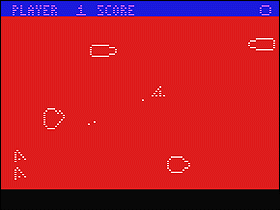 The Game: On a somewhat fantastic voyage into the human body, you’re in a tiny ship (presumably with Martin Short along for the ride) on a mission to blast diseased cells out of the bloodstream. Naturally, it’s not as easy a task as it sounds; the cells split into smaller cells when you zap them, and you have to clear even the tiniest remnants off the screen before advancing to the next treatment. (Arcadia, 1982)
The Game: On a somewhat fantastic voyage into the human body, you’re in a tiny ship (presumably with Martin Short along for the ride) on a mission to blast diseased cells out of the bloodstream. Naturally, it’s not as easy a task as it sounds; the cells split into smaller cells when you zap them, and you have to clear even the tiniest remnants off the screen before advancing to the next treatment. (Arcadia, 1982)
Memories: As with several of the earliest cassette-based games for the Supercharger add-on, Suicide Mission clearly owes a debt to an existing game that had already been released on the 2600. However, the prognosis is a bit grim here; this is a rare case where the game’s designers should made very sure that their game was an improvement on what came before. As both games suffer from severe sprite flicker, Asteroids comes out as the obvious winner here.
 The problem here is how Suicide Mission displays things on the screen. Like Asteroids, it’s subject to a constant flicker on the items that the player must shoot, but at least Asteroids‘s space rocks had the advantage of being solid. Suicide Mission‘s disease cells are hollow with a flickering outline, making it that much harder to see your target.
The problem here is how Suicide Mission displays things on the screen. Like Asteroids, it’s subject to a constant flicker on the items that the player must shoot, but at least Asteroids‘s space rocks had the advantage of being solid. Suicide Mission‘s disease cells are hollow with a flickering outline, making it that much harder to see your target.
 Worse yet, all of the game’s vital statistics – on-screen messages, scoring, and so on – are achieved through very similar means. Suicide Missions is a flicker-fest on a par with Pac-Man – certainly not something that one would expect from the much-touted Supercharger. It’s a decent enough Asteroids clone, but not a very pretty one.
Worse yet, all of the game’s vital statistics – on-screen messages, scoring, and so on – are achieved through very similar means. Suicide Missions is a flicker-fest on a par with Pac-Man – certainly not something that one would expect from the much-touted Supercharger. It’s a decent enough Asteroids clone, but not a very pretty one.
